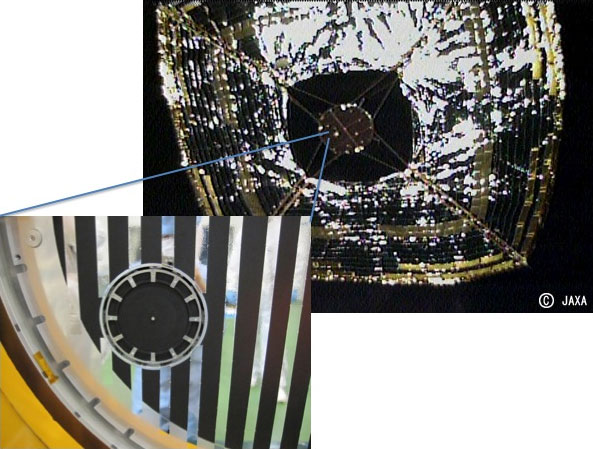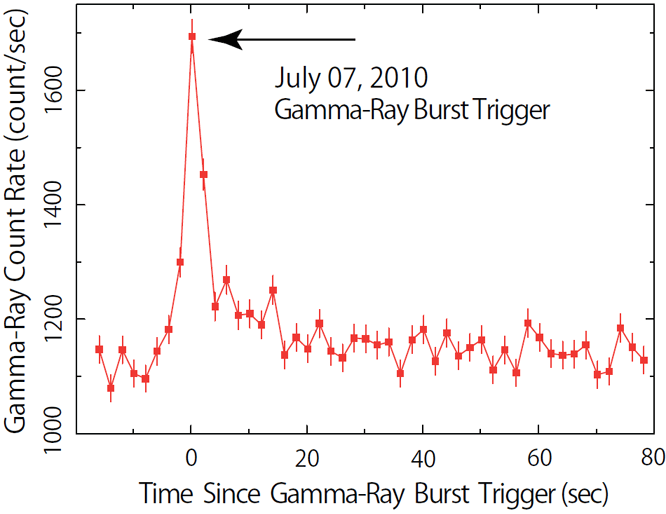Small Solar Power Sail Demonstrator 'IKAROS'
Successfully Observed Gamma-ray Burst
Japan Aerospace Exploration Agency (JAXA)
The Japan Aerospace Exploration Agency (JAXA) would like to announce that the GAmma-ray burst Polarized light detector (GAP) (*1,) which is aboard the Small Solar Power Sail Demonstrator "IKAROS," observed its first gamma-ray burst (*2) on July 7, 2010 (Japan Standard Time, the following dates and times are all JST.) The successful observation was confirmed through detailed analysis. The GAP is part of the scientific missions, aside from the navigation mission, of the IKAROS, which was launched from the Tanegashima Space Center on May 21, 2010. We will further aim to perform polarized light observations of gamma-ray busts.
Polarized light observations will contribute to elucidate the magnetic structure and the radiation mechanism of gamma-ray bursts, thus they are expected to greatly help solve the mystery of the death of massive stars and the birth of black holes.
(*1) The gamma-ray burst polarized light detector (GAP) was jointly developed by Kanazawa University, Yamagata University, and Riken, and is aboard the IKAROS's main body to conduct scientific missions aside from the solar power sail mission. The functional verification of the GAP started in late June, and it observed a gamma-ray burst immediately after the completion of the initial functional setup.
(*2) A gamma-ray burst is a huge explosion of a massive star at the end of its life, which creates a black-hole by radiating gamma-rays. It is known as the biggest explosion by scale in the universe, thus the burst can be observed from an extremely distant place as it is very bright. Gamma-ray bursts are the farthest celestial body known so far, created by star explosions.
(*3) Light has a vertical electric vector and a vertical magnetic vector against the light's moving direction. Such a light, whose vectors are polarized to a certain direction, is called "polarized light." A gamma-ray burst is extremely energetic, thus it is believed to flash out like a jet to both sides at almost light speed. Consequently, the direction of the gamma-ray, electric vector, and magnetic vector are highly polarized. To observe such light is called a gamma-ray polarized light observation. The polarized light of a gamma-ray burst hasn't been observed yet, and the GAP is trying to achieve the world's first gamma-ray observation. The GAP can observe gamma-rays coming in from the backside of the IKAROS's main body (or the backside of the solar cells.) Therefore, in order to carry out polarized light analysis, the light has to come in from the front side. In the case of the gamma-ray burst observed this time, the light did not come in from the front side of the GAP, thus it was not able to perform polarized light analysis. If we assume that a gamma-ray comes in from all directions at an equal probability, about 20 percent of gamma-ray bursts observed by the GAP will come from the direction that is favorable to polarized light observations.

17 cm in diameter, 17 cm in height, and 3.7 kg in weight. The small box on the left is the power source.


Backside of the IKAROS's main body
GAP on the IKAROS

College of Mathematics and Physics, Kanazawa University
Toshio Murakami, Daisuke, Yonetoku
Department of Physics, Yamagata University
Shuichi Gunji
RIKEN Advanced Research Laboratory
Tatehiro Mihara
|
|